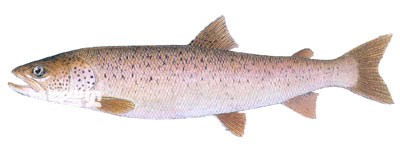Hucho taimen, also known as Hucho taimen, belongs to the order Salmoniformes, family Salmonidae, subfamily Salmonidae, and genus Hucho taimen. Commonly known as: Zheluo fish, Zheluo fish, Zheluo fish (Northeast), big red fish (Xinjiang). English name: Taimen, Huchen.
Endangerment level: Vulnerable.
The body is long, slightly flattened on the sides, and cylindrical. The head is flat, the snout is pointed, the mouth cleft is large, and it is positioned terminally. The maxilla is distinct and free, extending posteriorly behind the posterior edge of the eye. There are inwardly inclined sharp teeth on the upper and lower jaws, vomer and tongue. The scales are extremely small and oval in shape. The rings on the scales are arranged very clearly without radiating grooves. There are 193-242 lateral line scales and the lateral line is complete. The adipose fin is more developed. The back is greenish brown and the belly is silvery white. There are many small dark black cross-shaped spots densely packed like millet grains on the head and sides of the body. During the spawning period, both males and females appear bronze, and the lower lobes of the pelvic fin and tail fin are orange-red, which is more obvious in males. Pyloric caeca 205-219.

The salmon is a cold-water pure freshwater ferocious fish. It lives most of the year in streams with low temperatures (below 15°C) and fast currents. In winter, affected by the water level, they gradually move to the river or nearby deeper water bodies before freezing, looking for a suitable place to survive the winter. After the river opens in spring, they will migrate upstream to the streams for reproductive migration, and move to the main stream after August. Fishermen along the Heilongjiang River have a proverb of "Thin-scale fish, Zheluo fish, seven up and eight down", which refers to the migration pattern of fine-scale fish and Zheluo fish. Sexual maturity requires 5 years of age and the body length is 40-50 cm. The reproductive period begins in mid-May, when the water temperature is around 5-10°C. The broodstock fish gather in small rivers with fast currents and gravel bottoms to spawn. The broodstock fish spawn in the same way as salmon. Parent fish have the habit of burying eggs and protecting the nest. A large number of fish die after spawning, especially male fish. The larvae like to lurk in the gaps between the gravel and do not swim often. The jelly fish is very voracious and is one of the most ferocious species of freshwater fish. The foraging time is mostly before sunrise and after sunset, swimming from deep water to shallow water shores to prey on other fish and snakes, frogs, rodents and water birds that move in the water. At other times, they usually lurk in the shaded bottom on both sides of the stream. They feed all year round. In summer, when the water temperature is slightly higher, their appetite is poor and they may even stop eating. In winter, they do not stop feeding, but only during the reproductive period.
Zheluo salmon is mostly distributed in the Heilongjiang, Tumen River, Irtysh River and other water systems in my country. Abroad, it is distributed in the Lena River to the Pechora River in Siberia, Russia, and the Volga River and the upper reaches of the Ural River in Eastern Europe.
The salmon grows very quickly and develops at an equal speed, and it is a large economic fish. Generally, individuals weigh more than 3 kilograms, and the larger ones can reach 50 kilograms and grow more than 1 meter. The meat is delicious and tender, and it is a nutritious fish. It is also a specialty of alpine areas and is a precious food in the production area.
There are no detailed reports on the resource amount of Chloro salmon, but according to the "Fishery Resources of Heilongjiang Province" (1985), the number of Chloro salmon in Heilongjiang has decreased significantly compared with the past, and it accounts for almost no proportion in the province's catch. Mainly due to overfishing during the breeding period, the recruitment population has been greatly reduced, and environmental pollution has destroyed the environmental conditions for survival, resulting in a significant decline in resources. Effective protective measures have not yet been developed.
animal tags:
We created this article in conjunction with AI technology, then made sure it was fact-checked and edited by a Animals Top editor.